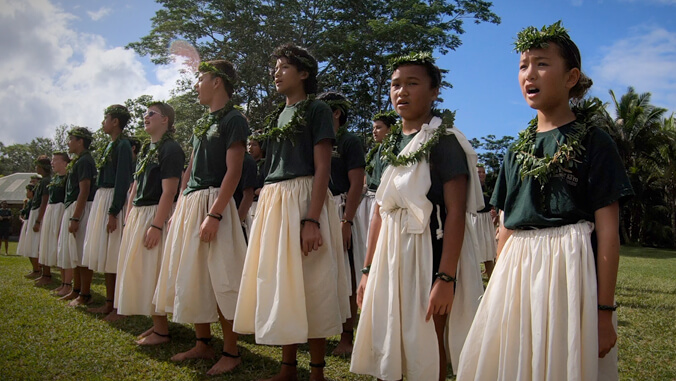“E hō mai ka ʻike mai luna mai ē” (Grant us the knowledge from above) chanted more than 300 students and members of Edith Kanakaʻole’s family in a special celebration in May. It was a vibrant day of hula, oli (chant), mele (song) and learning that honored the renowned teacher, dancer, singer and composer—a day of living out Edith Kanakaʻole’s rich legacy.

The Edith Kanakaʻole Foundation hosted the event in Keaukaha to honor the cultural icon, who is now memorialized in the Edith Kanakaʻole quarter. Students came from Ka ʻUmeke Kāʻeo Hawaiian Language Immersion Public Charter School, Keaukaha Elementary School and Ke Ana Laʻahana Public Charter School.
The festivities included Edith Kanakaʻole’s children, grandchildren and great grandchildren, and representatives from the U.S. Mint, the Smithsonian Women’s History Museum and the National Museum for the American Indian.
“Just me being able to get out there and to hula for my grandmother to honor her in the ways of hula that are meant for her that really impacted me pretty hard today,” said great grandson Keao Killion, a Ka ʻUmeke Kāʻeo Hawaiian Language Immersion Public Charter School student. “Because of the fact that she left all these hulas, all of these dances, all of these songs, meles, not only for us to know but to pass on to our next generation and for us to teach, not for us to hold on to it or to let it die out.”
Kaniaulono Hāpai, a 10th grader, said, “I felt very humbled to dance in front of her kids because this is their legacy, this is Aunty Edith’s legacy, and I just wanted to make sure that everything happened as it should happen because this is our one chance to honor her.”
Edith Kanakaʻole’s legacy: Just do it

Edith Kanakaʻole taught at the University of Hawaiʻi at Hilo and Hawaiʻi Community College in the 1970s. Today, her granddaughter Huihui Kanahele-Mossman serves as executive director of Edith Kanakaʻole Foundation and UH Hilo kuleana (responsibility) and curriculum development coordinator.
“I think it’s important for people to know that much like grandma did, we need to participate in ʻāina (land), we need to know how to participate in ʻāina through chant, through hula, through ceremony because that was one of the strongest points that she made while she was alive,” Kanahele-Mossman said. “What I want people to know is go ahead and feel free to do that at any point in time that they need to do that because that’s what she wanted part of her legacy to be.”
The Edith Kanakaʻole’s family recently established the Hale Edith Kanakaʻole Fund with the UH Foundation, in recognition of Edith Kanakaʻole’s numerous contributions toward the promotion of Native Hawaiians’ educational pursuits. The fund provides support to students enrolled at any campus within the UH System with a preference for students of Native Hawaiian ancestry. Donations to the Hale Edith Kanakaʻole Fund can be made via the UH Foundation.
Always seek knowledge

The Keaukaha area is special and is where Edith Kanakaʻole helped to create a Hawaiian language program for a public school to perpetuate the Hawaiian language.
Workshops for the day included: hei, the skill of creating string figures; palaʻie, the loop and ball game; the hula “E komo ma loko a o Halemaʻumaʻu,” original choreography by Edith Kanakaʻole; “Pua Melie,” another of Edith Kanakaʻole’s famous songs; introduction to the art of ʻulana (weaving) lauhala (pandanus) leaves; and a virtual huakaʻi (trip) through Keaukaha, exploring the place names Edith Kanakaʻole describes and writes about in her song, “Nā Pana Kaulana O Keaukaha.”
“Remembering Aunty Edith is something very important to our community of Keaukaha, because she’s done so much, not only for the whole world but especially for us individually,” said Hāpai. “And ‘E hō mai ka ʻike’ is a famous line of hers that means, ‘to instill all the knowledge into us,’ and that is something that should be spread to everyone, to always seek knowledge.”
—By Kelli Abe Trifonovitch


